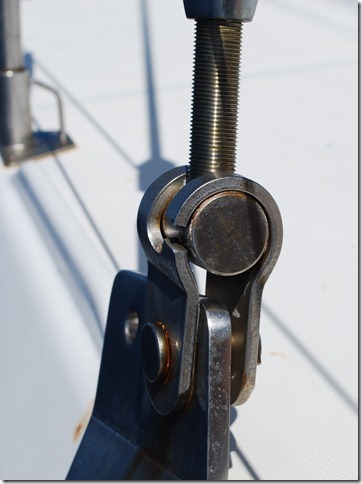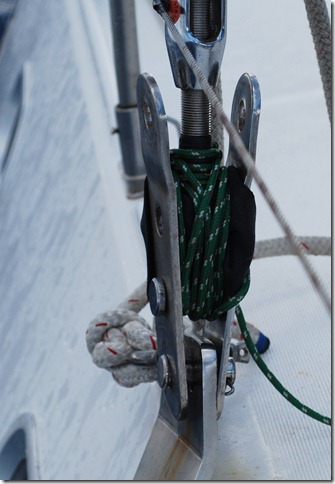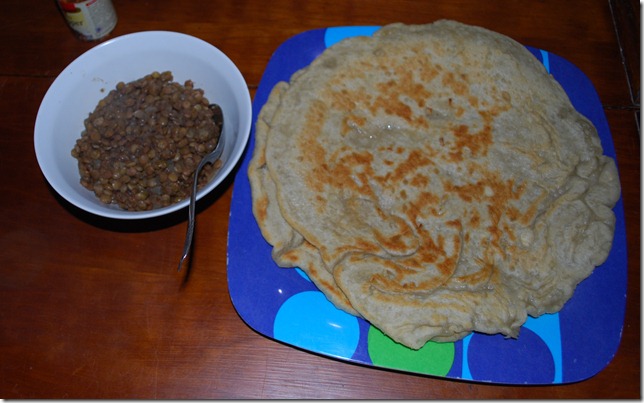Lat: 12 37.037′ S
Lon: 58 56.775′ E
After dinner last night, I had a short call with Colin Mack of Mack Sails in Florida (thanks to Tim for helping us set up the call). Mack Sails helped us re-rig the boat in Ft. Pierce before we left and Colin’s been great at taking calls and answering questions on the two occasions that we’ve been far from boating resources and had concerns about the rig. He’d read over the issue and temporary fix on the blog and recommended we secure the shroud with a strong shackle instead of a lashing with small line that could chafe through easily. Although I didn’t trust the lashing enough to sail, it wasn’t chafing and I still hadn’t been able to come up with a good shackle solution.
The problem was finding the right sized shackle, one small enough to fit through the turnbuckle but large enough to be able to encircle both the turnbuckle and the clevis pin. After finding nothing that would work, I started looking around at everything on the boat to see what I could possibly use that hadn’t yet come to mind. In the anchor locker I found just the right thing–large, pear-shaped stainless shackles that we occasionally use for our anchor bridle. The size was just right, so there was only one problem left to solve.
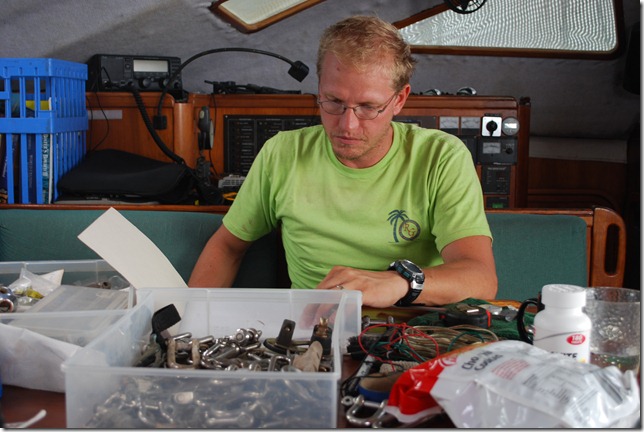 The table was covered with shackles, etc. for a couple of days
The table was covered with shackles, etc. for a couple of days
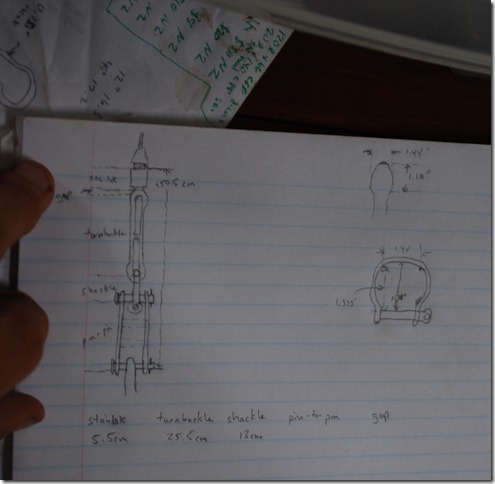 Drawing out a better solution and trying to get the spacing correct
Drawing out a better solution and trying to get the spacing correct
The new problem was tensioning the shroud. Usually you would just loosen and re-tension it by turning the turnbuckle, but with the jury-rig shackle attached, the turnbuckle would be frozen in place and would instead have to be pre-adjusted to the proper length. After some careful measurements (which I somehow managed to screw up even with a detailed drawing and measuring twice) we got started. Lauren turned the boat downwind and we loosened the starboard shroud until we couldn’t safely loosen it any more. As we loosened it, we also tightened the mast-supporting halyards on the port side, slowly bending the mast to port and creating slack to work with in the port shroud. The key was finally figuring how how to rig a block so that we could use a winch to pull down the shroud itself with lots of force while still keeping it lined up with where we needed to attach it. Eventually it was in place, and after a couple of tense moments fixing the clevis and cotter pins in place while the block was groaning, we were finally re-rigged with all stainless. We finished by re-tightening the starboard shroud, adding a backup lashing to the port jury-rig, and cleaning up. This time around, the seas were much calmer and we didn’t have to deal with the mast shaking and dancing above us. The rig is still looser than it should be, but tonight I’ll feel comfortable sleeping below instead of up in the salon waiting for something to let go. We still have the main halyard and topping lift tied off as backup supports and the re-rigged shroud has three backup attachments, so even if our repair lets go, we shouldn’t lose the mast. I’m also really looking forward to a day without working in such close proximity to hardware under high loads.
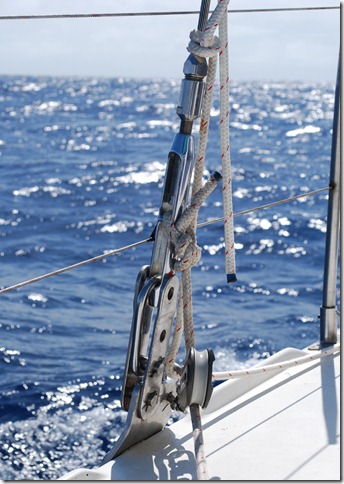 We ended up making a spacing change and adding a backup lashing, but this it what basically what we ended up with.
We ended up making a spacing change and adding a backup lashing, but this it what basically what we ended up with.
We have half a jib out now and were making 3.5 to 4 knots before a squall came through and the wind died down to almost nothing. Hopefully we’ll feel good enough about things tomorrow to put the whole jib out. The good news is that even if it’s slow going, we’re sailing and feel much better about the rig. Thanks to everyone who’s helped us out. It looks like the next challenge is going to be getting into port and then finding a way to get a replacement part before the tough journey down the Mozambique channel.
Lat: 12 40.251′ S
Lon: 61 11.557′ E
Just a quick update to let everyone know the stick is still up and we’re moving along. After looking at a few options, including the sparsely inhabited Agalega Islands, it looks like we’re headed to Antisiranana (Diego Suarez). It’s the closest port of entry and thanks to the SSB and Bob on Boomerang, we’re getting an email full of info on it. Apparently they don’t get many boats, and there was a Swiss boat that was treated so well that they spent 2 months there. Evidently theft is a big enough issue that you have to hire someone to stay on the boat and protect it, but other than that they loved it an even have contact info for an engineer working in the shipyard. We’re marginal on fuel in terms of getting there by motoring the whole time, so we’ll probably try to rig a makeshift sail tomorrow. I still don’t trust the rig enough to use the jib, but I think we can rig a storm sail in a way that doesn’t strain things.
Most of today was spent working on the engines. With the unexpected motoring, one engine needed an oil change, a water temperature gauge failed, and I found yet another screw hole in the hull leaking in the starboard engine room. When I took a closer look on the port side, I found at least a dozen holes, but none of them are leaking.
Bob on Boomerang and Nat on Bahati really came through for us as well. I’d emailed Nat asking for info on the Agalegas, which are administered by Mauritius, where he just made landfall yesterday. Even though he had his own boat repairs and a fall on land that resulted in being knocked out and visiting the hospital, he managed to get some valueable info. The Agalegas don’t have regular air service and the supply boat schedule is irregular, not someplace to be stuck trying to get a part. Bob had collected info on Diego Suarez for us from the Swiss boat.
The weather the last couple of days has been the best of the trip. We have clear skies for the first time, no squalls, and the seas are down a bit. Although there are still occasional 8+ footers, we can actually see the horizon. It would have made for some incredible sailing, but for now we’re just happy to still be in one piece.
Lat: 12 42.495′ S
Lon: 62 31.360′ E
About 6:30 am yesterday, I was resting sleepily on the settee between 15-minute checks when I heard the sound of metal breaking under load. It sounded like it had come from the mast, so I hurried outside and looked over the mast and rig, but didn’t see anything. The sound was unmistakable, though, and I kept looking for the source every 15 minutes when I went out to check. About 8:30, I happened to glance at the port chainplate and saw it: the port (windward) cap shroud toggle had broken on one side and was opening up. The other side of the toggle had held, but couldn’t do so for long. We have a three-point rig, which means that the mast is held upright by three 1/2″ stainless steel wires stretching from the masthead to the deck. The forestay runs from the masthead to the foredeck, and one cap shroud runs from the masthead to the aft starboard side of the boat, while another cap shroud runs to the aft port side. Being only a 3-point rig, if any of them fails the mast will come down, and there was only a small bit of stainless left holding our port cap shroud up.
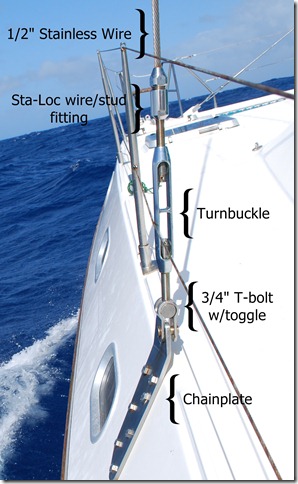 Hardware holding the port cap shroud to the boat (photo taken the day before the failure)
Hardware holding the port cap shroud to the boat (photo taken the day before the failure)
I woke Lauren up, and we furled the jib to reduce the strain on the rig, started the engine, and then ran the main halyard and topping lift to the aft port portion of the boat and winched them tight to help take the load off the damaged shroud. Much to my chagrin, I don’t have any spare cap shroud fittings, so I began looking through spares and parts to see what could be used to effect an emergency repair. To make a long story short, everything I could think of seemed to be one piece short, and it took until sunset to come up with something that seems to be holding for now. We first removed the broken piece while the rig was being held by the halyard and topping lift and then used shackles, line and a winch to tighten it back up a bit. There were several failed attempts at a repair, and each time I had to disconnect the shroud and leave it tied by a line, not taking any load. When the boat was rolled by a wave, the loose shroud would swing and jerk against the line, and the mast would shudder and dance ominously. The last attempt involved cutting off the broken toggle piece and lashing the threaded stud to a new toggle of sorts made from two old forestay tangs and a couple of clevis pins. The lashing was done with 5mm Sta-set using leather from an old laptop bag for chafe protection. This setup let us tension the shroud enough that things “feel” normal, although the halyard and topping lift are still holding a good part of the load.
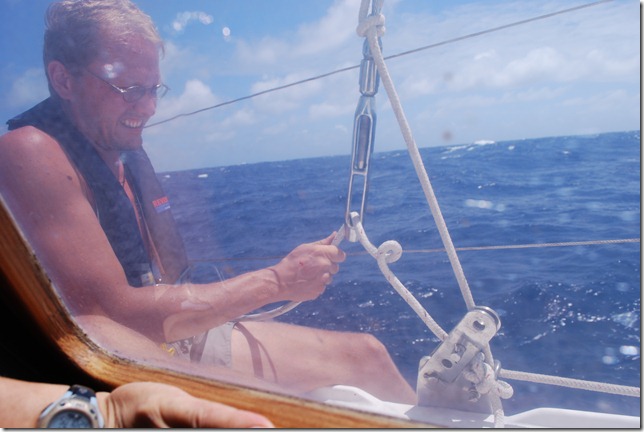 Wrestling the loose cap shroud into a temporary lashing while the mast is held by the main halyard and topping lift
Wrestling the loose cap shroud into a temporary lashing while the mast is held by the main halyard and topping lift
I’m writing this portion of the blog at about 4am, and hourly checks on the lashing haven’t shown any signs of chafe or wear yet. Unfortunately, we’re 770 miles from the cape, a bit less than that to Antisiranana (Diego Suarez), 150 more to Nosy Be, and 250 more to Mayotte. Mayotte is French and we could reliably have a new part sent there. The nearer locations are in Madagascar, and are not known for reliable delivery of packages. Our cruising guide, which was written about 15 years ago, recommends not having parts sent to Madagascar. We may have enough fuel to motor to Antisiranana, but to get to Nosy Be or Mayotte, we’d have to drift or sail as well.
I haven’t gotten up the nerve to sail yet on our jury-rigged rig, but we may have to at some point. It would be nice. It would also be nice to go up the stick to attach a strong new line in a location that won’t chafe, but so far the consensus is that it’s not worth the risk.
Needless to say, it was really nice to hear another voice on the SSB tonight when we tuned in. Bob and I talked things over a bit. I’m always thinking about what can go wrong, so it was nice to hear some confidence from him that the halyards could hold things. Today I’ll try to talk to the rigger that helped us re-rig the boat in Ft. Pierce and get some more advice. Lauren and I have already started talking over daily adjustments to prevent chafe, etc. and will be trying to make the makeshift rig as reliable as possible. It’s also nice that our last weather report showed lighter winds for the next week or so. Just yesterday we were enjoying watching the big seas, but now every wave that jostles the boat makes me wish for calm seas and 10 knots of wind instead of the 20+ we often have.
We definitely have our hands full, but we’re doing well, have the communication we need, have managed to keep the stick up for now, and are developing a plan.
Lat: 12 58.545′ S
Lon: 65 38.785′ E
Most of the time, we’re pretty happy adventuring on the other side of the world but tomorrow will be an exception. My cousin Melanie is getting married on Sunday, and while we’d love to leave the boat on autopilot, catch a passing freighter, fly to the US for the wedding, and then retrace our steps back (Pura Vida would still be sailing toward Cape d’Ambre), it would be a bit of a stretch. Tomorrow will definitely be the day I’ve most wished to be back in the states (OK, those two days of seasickness in the Caribbean are a close second). We love you Melanie, and wish you and Michael the best. We promise we’ll bring you a well-travelled wedding gift, but shipping will probably be about 8 months.
We made a couple of milestones today: we entered a new time zone (GMT+4), and we now have less than 1000 nm to the Cape d’Ambre at the northern tip of Madagascar. We’re averaging over 6 knots so far, and except for the 36 exciting hours when we had a double-reefed main up, it’s all been just the jib, which is definitely our workhorse sail. The sailmaker in Block Island, Florida definitely did right by us when he re-stitched the whole jib after we dropped it off for a small repair.
You’d think we would be going crazy about now, but we’re not. In a complete reversal of her initial reservations, Lauren is really enjoying the time out here. She was actually talking yesterday about wanting stay out here enjoying the beauty and peace (did I mention we haven’t run out of cheese yet?). I can definitely understand her perspective. The days have been sunnier lately with fewer squalls and the seas, though still large at times, aren’t as rough and confused as they were earlier in the trip. With the weather forecast calling for lighter winds the rest of the way, it’s looking like the roughest part is behind us. You might think we’d get bored out here, but we haven’t yet.
If you’ve ever been to the beach and been mesmerized by the sight of the waves breaking, then you’d probably understand how we never get tired of watching the waves. Waves on a beach are just plain boring after you’ve had a chance to watch mid-ocean waves. Beach waves are almost all the same; no matter how far they’ve travelled they all meet a similar demise, standing up and curling until they break into white water and spend the last of their energy in a flattened surge up the beach. In mid-ocean, they’re much more diverse and dynamic. Surfers have a myriad of names for the various shapes a breaking wave can take, but sailors haven’t been as creative in naming the offshore shapes. Like Lauren described in the last blog, some of the more exciting ones are fast and steep, rushing toward you, often with a foamy, breaking crest. Laying in the salon, we can see the crest of the large wave towering above the solar panels and speeding towards us. Just when you think, “Wow, this one’s going to get us” it disappears as the boat rises gracefully on the face of the wave and in a second it’s underneath us, sometimes with a slap on the underside of the bridgedeck, and in the next second it racing off toward Oman and all we can see from down in the trough is its steep back and white crest. You could go on for a while about the long, smoothed-out, slow rollers that amble in from distant storms, looking more like minor geographic features, the short, steep, squall-driven waves, the occasional steep ones from the south that slap you on the side or give you a quick knock-around by lifting one hull while dropping the other, and the big foamy ones from directly astern that gurgle like white water between the hulls while they slide underneath us. Watching them out there as they’re all superimposed, crossing paths, riding over each other, swelling up in lumps, or charging in a line makes you feel lucky to be out here.
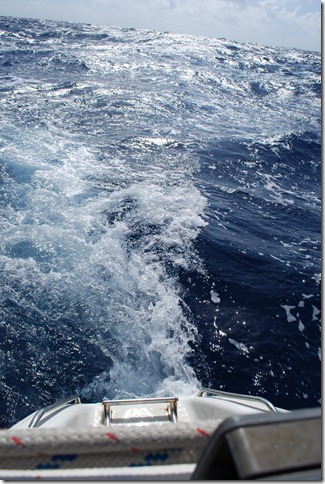 Leaving the Indian Ocean in our wake as we slide down a wave
Leaving the Indian Ocean in our wake as we slide down a wave
It still amazes me that we see birds every day, no matter where we are. It’s astounding to me that they can survive at such great distances from land, always counting on plucking their next meal from the sea and navigating the featureless oceans instinctively. Now that we have a radio, they’re not our only companions. Getting to talk to someone for a couple of minutes every during a net and listening to news and entertainment broadcasts really adds to the day. Unlike in the Pacific, we also see quite a few cargo ships. Most of them only show up on the AIS, and don’t come into sight, but a few have come within 2-4 miles, which is pretty close out here. We’d stopped seeing them on the AIS for a couple of days and I thought perhaps we were out of the shipping lanes that run from South Africa to Asia when Lauren sighted a ship only a few miles away that didn’t show up on AIS. I tried calling them on the radio to check the status of their AIS transmitter, but got the not so unusual no-response. After a reboot of the AIS and chartplotter, we now see ships crossing our path on a regular basis again.
The last couple of afternoons have been dedicated to repairing leaks. Both the leak in the port forward cabin and the starboard engine room turned out to have the same cause. Someone who was either ignorant or lazy beyond even my capacity for such things decided to install something by screwing mounting screws directly into the hull below the waterline instead of using more appropriate methods. The downside of drilling or screwing a hole into your boat’s hull below the waterline would seem to be obvious, but I guess it’s not enough to prevent a shortcut in some cases. A bit of underwater epoxy has stopped up the leaks, but the water damage will probably take more work to remedy in spots.
With our 12th nightfall and the customary sunset squall behind us, it’s time to enjoy a couple of treats — the now full moon rising through the scattered clouds and a delicious garlic naan Lauren just finished making. Mmmm.
Lat: 13 04.346′ S
Long: 70 11.721′ E
These last couple of days have been some of our best of the passage. We are making great time without even trying. We did get inspired to put up a double-reefed mainsail a couple of days ago when our speed dwindled down to 5 knots, but we dropped the main around midnight that night when we were careening down waves at 10 knots! Getting it down in the dark in pretty strong winds and 10′ seas was pretty exciting. We got out our harnesses for the first time on the passage and clipped onto something while on deck. You can’t be too careful in that situation.
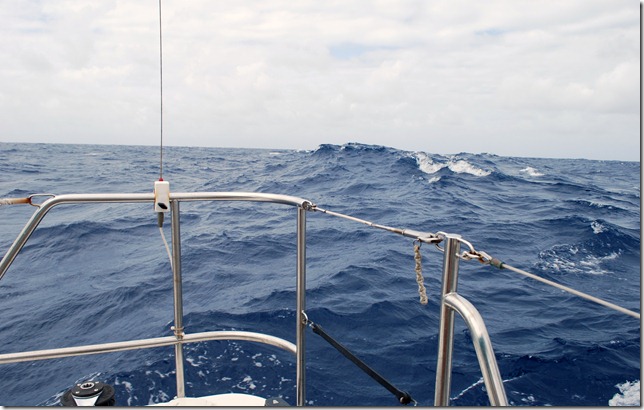 Cresting waves make for boat surfing
Cresting waves make for boat surfing
Since then, the trusty jib has continued to move us in the right direction at an average speed of 6.3. Yesterday was our best day — 180 miles! That might be a record for Pura Vida, although we had some similar days on the passage from the Galapagos to the Marquesas. We also crossed the halfway point yesterday, which is a major milestone. It feels like we are on the downhill slope even though we still have over 1200 miles to go before we are safely anchored in Nosy Be, Madagascar and having a celebratory toast.
Neither of us are in a race against time at this point. I mentioned in my last blog that Dallas was finding projects to keep him busy. Well, eventually he ran out of those, but he has been a quick study of the art of doing nothing (I’m a good teacher, LOL), and we have been engaging in a lot of practice together over the last two days. We listen to music or the news, watch the waves, reminisce, tune in for our twice daily radio chat, cook, do dishes, shower, read or work on a puzzle, look out for other boats, watch the weather, and that’s about it. Somehow that’s enough to make the hours fly by–when we’re not on watch, that is. The wee hours of the morning can get a bit long.
Some days we are more active than others. Laziness creeps in insidiously, sapping my motivation, but each time I make an effort to overcome it and get off of the settee, I feel better for it. Even a seemingly mundane chore such as doing dishes in the cockpit can be enough to fire up my engine and brighten my day. Then there’s usually leftover energy to devote to exercising or having my own private dance party in the cockpit. (Of course Dallas is invited to the party, but he usually sends his regrets, LOL.)
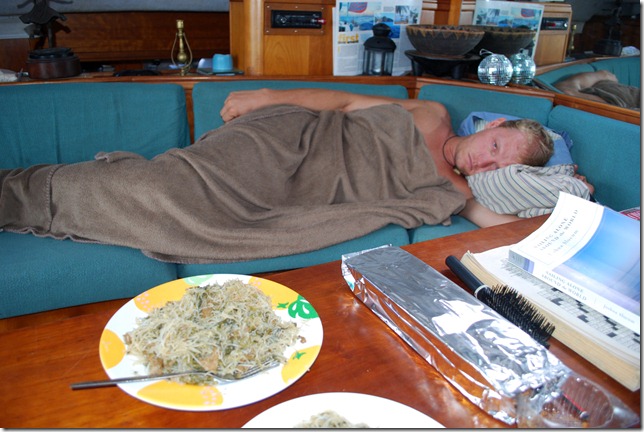
In big seas even getting up to eat can feel like a chore
Our energy level also depends on the sea state. Lately the seas continue to be quite large (up to 12′) but from the aft quarter (the southeast), like the wind. This makes for a comfortable motion and doesn’t interfere with our activities. Occasionally, though, we get large waves across the beam that rock the boat a bit. They typically strike when Dallas is in the cockpit checking our course, as if they know that this is a sailor who really hates to get wet! Last night we took a big one on the beam while Dallas was chatting with S/V Bahati on the radio, and it sent part of our dinner flying from the table to the settee beside him. Nat from Bahati is normally very sympathetic, but in this case just said, “I’m glad to hear catamarans get some of that, too.”
I haven’t spent much time on monohulls, so I can’t really compare, but I love the way the cat glides over big waves from the stern. We can be down in the trough of a wave and looking up at the next one, much higher than the boat, that looks as though it is going to break on top of us, when all of the sudden we find ourselves sitting on top of it. Then we simply glide down into its trough, or if its a particularly steep wave, surf down it, which, in the case of these waves on the port quarter, means that our stern gets pulled very quickly to starboard. Meanwhile the amazing autopilot is constantly counteracting to keep us on course. (I hope that our friends on S/V Marionette are coping with the wind and waves as they hand-steer to Africa! At least they are headed to Mauritius, which makes for a shorter passage.)
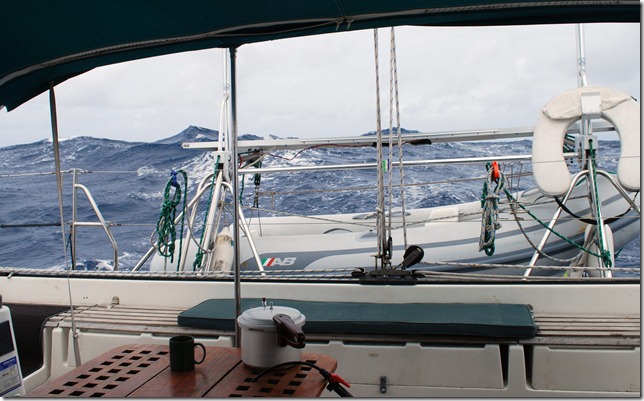
A big one coming up on our stern
The boat is holding up like a champ except for a possible slow leak somewhere in the port hull. Dallas found the port bilge full of water today and is trying to diagnose the problem. More on that later…
We hope everyone back home is doing well and enjoying some leisure time of their own.


